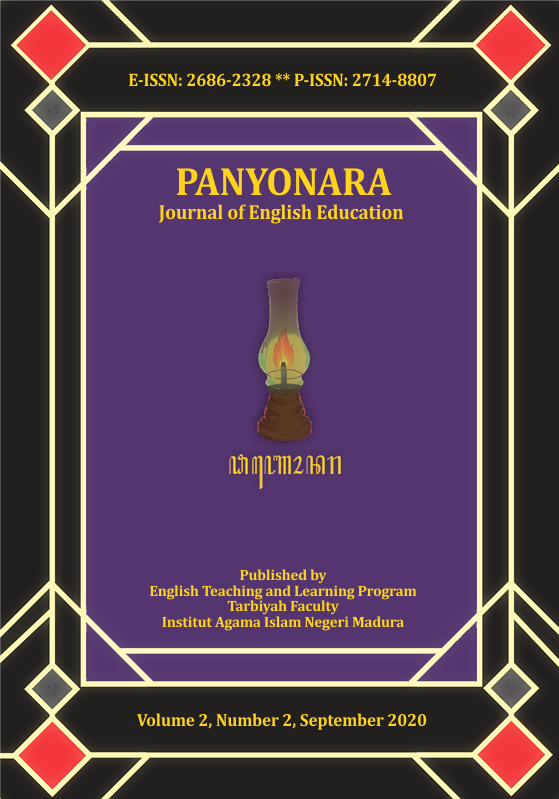Error Analysis on Voicing Sounds Uttered by English Department Students at State Islamic Institute of Madura
 Abstract views: 365
,
Abstract views: 365
,
 PDF downloads: 495
PDF downloads: 495
Abstract
Downloads
References
Alhaddad, I., Kusumah, Y. S., Sabandar, J., & Dahlan, J. A. (2015). Enhancing Students Communication Skills through Treffinger Teaching Model. JME: Journal on Mathematics Education, 16(1), 31–39.
Atli, I., & Bergil, A. S. (2012). The Effect of Pronunciation Instruction on Students’ Overall Speaking Skills. Procedia - Social and Behavioral Sciences, 46, 3665–3671. doi: 10.1016/j.sbspro.2012.06.124.
Cahyono, B. Y., & Widiati, U. (2015). The Teaching of EFL Listening in the Indonesian Context: The State of the Art. TEFLIN Journal, 20(2), 194–211. doi: 10.15639/teflinjournal.v20i2/194-211.
Demirezen, M., & Kot, E. (2016). Collegial Reactions to Faulty Pronunciation of Teachers in Relation to English Language Teaching. Procedia - Social and Behavioral Sciences, 232, 471–478. doi: 10.1016/j.sbspro.2016.10.064.
Gowhary, H., Azizifar, A., & Rezaei, S. (2016). Investigating English Vowel Reduction in Pronunciation of EFL Teachers of Schools. Procedia - Social and Behavioral Sciences, 232, 604–611. doi: 10.1016/j.sbspro.2016.10.083.
Hansen, D. (1995). A Study of the Effect of the Acculturation Model on Second Language Acquisition. In Eckman, Fred R., Jean Mileham, Rita Rutkowski Weber, Diane Highland, and Peter W. Lee. Second Language Acquisition Theory and Pedagogy. New Jersey: Lawrence Erlbaum Associates. New Jersey: Lawrence Erlbaum Associates.
Jones, D. (1972). The Pronunciation of English. Cambridge: Cambridge University Press.
Jones, D. (1975). An Outline of English Phonetics. Cambridge: Cambridge University Press.
Karlina, Y., Rahman, A., & Chowdhury, R. (2020). Designing Phonetic Alphabet for Bahasa Indonesia (PABI) for the teaching of intelligible English pronunciation in Indonesia. Indonesian Journal of Applied Linguistics, 9(3), 724–732. doi: 10.17509/ijal.v9i3.23223.
Kurniawan, D. (2016). The Error Analysis of the Pronunciation of Dental Fricative Consonants (/ϴ/, /ð/) by the Students of English Education Study Program Faculty of Teacher Training and Education Sriwijaya University. The Journal of English Literacy Education, 3(2), 7. 157-163. doi: 10.36706/jele.v3i2.3619.
Nilsen, D. L. F. (1973). Pronunciation Contrasts in English. New York: Regents Publishing Company, Inc. New York: Regents Publishing Company, Inc.
O’Grady, William, John Archibald, and Mark Aronoff., W., Archibald, J., & Aronoff, M. (1989). Contemporary Linguistics: An Introduction. New York: St. Martin’s Press.
Rogers, H. (2000). The Sounds of Language: An Introduction to Phonetics. London.
Sembiring, N., & Fiber, Y. A. (2016). An Analysis of Pronunciation errors made by the fourth-semester students of the English education study program at UNIKA. Jurnal Suluh Pendidikan. 3(1).
Tuan, L. T. (2010). Teaching English Discrete Sounds through Minimal Pairs. Journal of Language Teaching and Research. 1(5). 540-561, doi: 10.4304/jltr.1.5.540-561.
Wafi, A. (2011). Using the Think-Pair-Share Strategy to Increase Students’ Active Involvement and to Improve Students’ Speaking Ability at Islamic the University of Malang (Dissertation). Universitas Negeri Malang.
The journal uses an Open Access policy under a Creative Commons Attribution-NonCommercial 4.0 International License. Authors who publish with this journal agree to the following terms:
- Authors retain copyright and grant the journal right of first publication with the work simultaneously licensed under a Creative Commons Attribution License that allows others to share the work with an acknowledgment of the work's authorship and initial publication in this journal.
- Authors are able to enter into separate, additional contractual arrangements for the non-exclusive distribution of the journal's published version of the work (e.g., post it to an institutional repository or publish it in a book), with an acknowledgment of its initial publication in this journal.
- Authors are permitted and encouraged to post their work online (e.g., in institutional repositories or on their website) prior to and during the submission process, as it can lead to productive exchanges, as well as earlier and greater citation of published work.
















